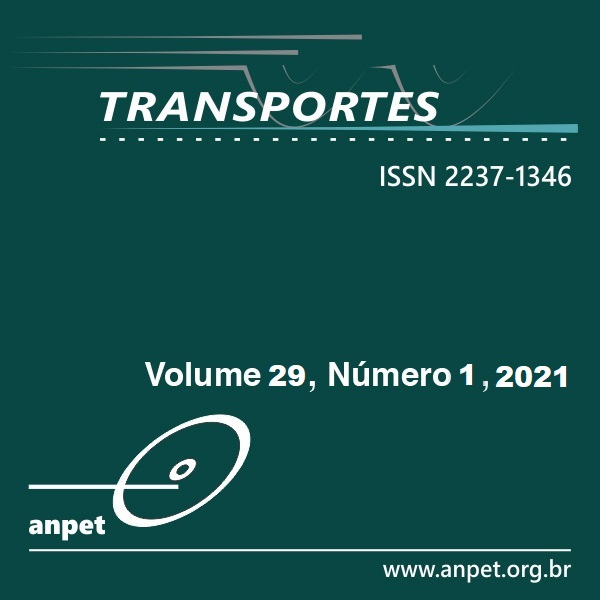Verificação de vulnerabilidades em redes de transporte: uma abordagem pela teoria dos grafos
DOI:
https://doi.org/10.14295/transportes.v29i1.2250Palavras-chave:
Vulnerabilidade, Resiliência, Sistemas complexosResumo
O projeto e a manutenção de sistemas de transporte sustentáveis e resilientes dependem da identificação de possíveis vulnerabilidades antes que as crises ocorram, para que a infraestrutura e as estratégias de ação sejam efetivamente desenvolvidas em tempos de crise. No entanto, dada a complexidade dos sistemas de transporte, os métodos propostos para avaliação de vulnerabilidades são de difícil implementação e requerem dados inacessíveis para a maioria dos municípios brasileiros. Diante desse cenário, e com o intuito de simplificar a análise preliminar de um sistema em busca de vulnerabilidades, o objetivo deste trabalho é apresentar a medida de centralidade da teoria dos grafos que melhor representa a vulnerabilidade local das redes de transporte terrestre nas cidades brasileiras. O método proposto no estudo foi a degradação sistemática da rede medindo o decaimento de continuidade no sistema, definida como a proporção de caminhos válidos que permanecem na rede após a remoção de um determinado número de vias. Os resultados apontaram que a centralidade de intermediação é a métrica que melhor reflete a vulnerabilidade, uma vez que a estratégia de ataque que remove progressivamente as estradas com maior centralidade de intermediação apresenta um declínio mais rápido da continuidade. Com este resultado, esperamos facilitar a detecção de vulnerabilidades nos sistemas de transporte e orientar a criação de sistemas de transporte mais resilientes.
Downloads
Referências
Appert, M. and C. Laurent (2013) Measuring urban road network vulnerability using graph theory: the case of Montpellier’s road network theory: the case of Montpellier’s road network. La mise en carte des risques naturels, pp. 1–22.
Berche, B.; C. Von Ferber; T. Holovatch and Y. Holovatch (2009) Resilience of public transport networks against attacks. Euro-pean Physical Journal B, 71(1), pp. 125–137. doi: 10.1140/epjb/e2009-00291-3.
Cox, A.; F. Prager and A. Rose (2011) Transportation security and the role of resilience: A foundation for operational metrics. Transport Policy, 18(2), pp. 307–317. doi: 10.1016/j.tranpol.2010.09.004.
Folke, C.; S. R. Carpenter; B. Walker; M. Scheffer; T. Chapin and J. Rockström (2010) Resilience thinking: Integrating resilience, adaptability and transformability. Ecology and Society, 15(4). doi: 10.5751/ES-03610-150420.
Instituto Brasileiro de Geografia e Estatística (IBGE) (2018) Estimativas de população. Available at: <https://ftp.ibge.gov.br/Estimativas_de_Populacao/Estimativas_2018/POP2018_20210331.xls> (Accessed: 23/March/2019).
Ip, W. H. and D. Wang (2011) Resilience and friability of transportation networks: Evaluation, analysis and optimization. IEEE Systems Journal, 5(2), pp. 189–198. doi: 10.1109/JSYST.2010.2096670.
Leu, G.; H. Abbass and N. Curtis (2010) Resilience of ground transportation networks: A case study on Melbourne. ATRF 2010: 33rd Australasian Transport Research Forum.
Litman, T. (2006) Lessons from Katrina and Rita: What major disasters can teach transportation planners. Journal of Trans-portation Engineering, 132(1), pp. 11–18. doi: 10.1061/(ASCE)0733-947X(2006)132:1(11).
Lu, Q. C.; Z. R. Peng and J. Zhang (2015) Identification and prioritization of critical transportation infrastructure: Case study of coastal flooding. Journal of Transportation Engineering, 141(3). doi: 10.1061/(ASCE)TE.1943-5436.0000743.
Martins, M. C. M.; A. N. Rodrigues da Silva and N. Pinto (2019) An indicator-based methodology for assessing resilience in urban mobility. Transportation Research Part D: Transport and Environment, 77, pp. 352–363. doi: 10.1016/j.trd.2019.01.004.
Mattsson, L. G. and E. Jenelius (2015) Vulnerability and resilience of transport systems - A discussion of recent research. Transportation Research Part A: Policy and Practice, 81, pp. 16–34. doi: 10.1016/j.tra.2015.06.002.
Morelli, A. B. and A. L. Cunha (2019) Measuring urban resilience: A road network-oriented method. Available at: <http://arxiv.org/abs/1912.01739>.
Newman, M. (2010) Networks: An Introduction. doi: 10.1093/acprof:oso/9780199206650.001.0001.
Newman, P.; T. Beatley and H. Boyer (2009) Resilient cities: Responsing to peak oil and climate change. Australian Planner, 46(1), p. 59. doi: 10.1080/07293682.2009.9995295.
OpenStreetMap (2019). Available at: (Accessed: 27/March/2019)
Rodríguez-Núñez, E. and J. C. García-Palomares (2014) Measuring the vulnerability of public transport networks. Journal of Transport Geography, 35, pp. 50–63. doi: 10.1016/j.jtrangeo.2014.01.008.
Wang, Y.; H. Liu; K. Han; T. L. Friesz and T. Yao (2015) Day-to-day congestion pricing and network resilience. Transportmetrica A: Transport Science, 11(9), pp. 873–895. doi: 10.1080/23249935.2015.1087234.
Westrum, R. (2012) A typology of resilience situations. Resilience Engineering: Concepts and Precepts, pp. 55–66.
Zhang, X.; E. Miller-Hooks and K. Denny (2015) Assessing the role of network topology in transportation network resilience. Journal of Transport Geography, 46, pp. 35–45. doi: 10.1016/j.jtrangeo.2015.05.006.
Downloads
Publicado
Versões
- 17-05-2021 (2)
- 30-04-2021 (1)
Como Citar
Edição
Seção
Licença
Copyright (c) 2021 André Borgato Morelli, Andre Luiz Cunha

Este trabalho está licenciado sob uma licença Creative Commons Attribution 4.0 International License.
Ao submeter um manuscrito para publicação neste periódico, todos os seus autores concordam, antecipada e irrestritamente, com os seguintes termos:
- Os autores mantém os direitos autorais e concedem à Transportes o direito de primeira publicação do manuscrito, sem nenhum ônus financeiro, e abrem mão de qualquer outra remuneração pela sua publicação pela ANPET.
- Ao ser publicado pela Transportes, o manuscrito fica automaticamente licenciado sob a Licença Creative Commons CC BY 4.0. Esta licença permite o seu compartilhamento com reconhecimento da autoria e da publicação inicial neste periódico.
- Os autores têm autorização para assumir contratos adicionais separadamente, para distribuição não exclusiva da versão do trabalho publicada neste periódico (por ex.: publicar em repositório institucional ou como capítulo de livro), com reconhecimento da publicação inicial na Transportes, desde que tal contrato não implique num endosso do conteúdo do manuscrito ou do novo veículo pela ANPET.
- Os autores têm permissão e são estimulados a publicar e distribuir seu manuscrito online (por ex.: em repositórios institucionais ou na sua página pessoal) depois de concluído o processo editorial. Como a Transportes é de acesso livre, os autores são estimulados a usar links para o DOI do artigo nesses casos.
- Os autores garantem que obtiveram todas as permissões necessárias dos empregadores para a publicação e o licenciamento CC BY 4.0 do manuscrito, especialmente se o empregador possuir alguma reivindicação sobre os direitos autorais do manuscrito. Os autores assumem total responsabilidade por questões de direitos autorais relacionadas ao empregador, isentando a ANPET e a Transportes de qualquer responsabilidade relacionada.
- Os autores assumem toda responsabilidade sobre o conteúdo do manuscrito, incluindo as devidas e necessárias autorizações para divulgação de dados coletados e resultados obtidos, isentando a ANPET e a Transportes de toda e qualquer responsabilidade neste sentido.
Última atualização: 27/11/2025











